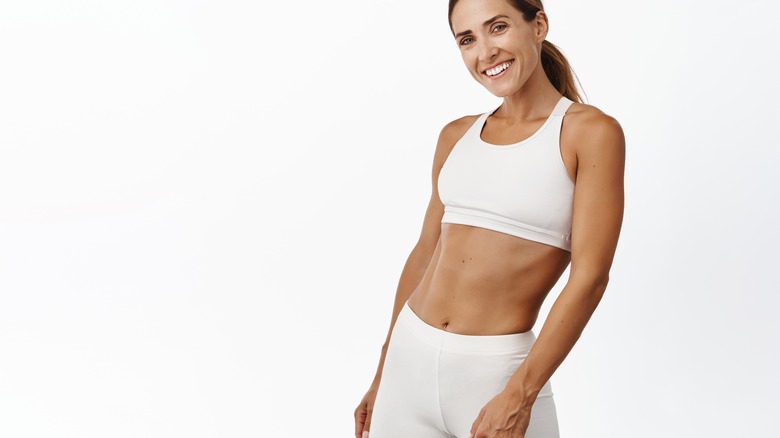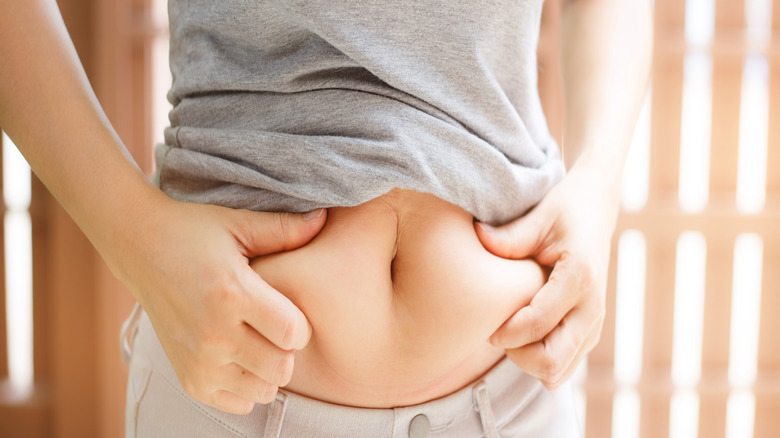The Real Reason Some People Only Have Four-Pack Abs
If you've been working hard in the gym, you may be waiting patiently (or not so patiently) for the day that you'll see six-pack abs. But for some people, that day will never come. And it's no fault of their own.
The abdominal region is comprised of four different sets of muscles: the rectus abdominis, transverse abdominis and internal and external obliques, according to Healthline. The rectus abdominis is comprised of the muscles that run vertically down the middle of your abdomen. A band of tissue called the linea alba separates them in the middle, and horizontal bands of fascia separate them into square or rectangle shapes. These create the "pack" we work so hard to achieve.
When abs are toned, whether you have a four, six, eight, or even 10-pack is determined by how many horizontal fascia bands you have, and that's something that's determined at birth. There's nothing you can do to create more bands.
Genetics determine your abs
Whether you develop four, six, eight, or even 10-pack abs is dictated before you are even born (per Healthline). By the time you're born, the number of tissue bands running horizontally across your rectus abdominis has already been determined.
Some people are born with only two horizontal bands of muscle, meaning that they'll develop a four-pack of abs if they combine appropriate exercise and diet habits. Other people are born with three horizontal muscle bands, denoting they can develop a six-pack. Then there are people who are born with four or five horizontal muscular bands, thus resulting in the potential for eight and 10-pack abs, respectively. You can credit your ancestors for the number of abs you develop in the gym, because according to Healthline, it's all a matter of genetics.
A 2021 review published by StatPearls noted that the fascia and musculature of the abdominal wall develop early during the gestation of an embryo. The authors also noted that a triangular muscle called the pyramidalis, which can be found anterior to the rectus abdominis, is formed bilaterally in 80% of people, and unilaterally or is absent in a smaller population of people. So not only do your genetics determine the number of visible abs you can develop, but your development as an embryo also governs the makeup of your lower abs below what would be considered your "ab pack."
The best way to get defined abs
Of course, not everyone will be able to see how many sets of abs they have, due to diet and exercise habits. For abdominal muscles to be visible, they have to be toned and there has to be very little fat stored around the midsection. Amanda Butler, a certified personal trainer, told Women's Health, "It can take anywhere from three months to a year to get a six-pack, and it's not just about doing a ton of ab exercises."
Butler recommends that, in addition to consistently working out your abdominal muscles with targeted exercises, you should add cardio to your routine. That's because getting your heart rate up helps burn belly fat, according to a review of 16 clinical trials, published in 2007, in the International Journal of Obesity. And in the kitchen, increase your protein intake while reducing carbs and fat. Protein helps the body recover after tough workouts and builds muscle, which will help your abs get stronger and allow them to be more visible.
Strong ab muscles aren't just for show, though. Abs are an important part of your overall health and fitness level. As a complete set, your abdominal muscles support your core, which helps provide strength and stability to your back and torso. Even short ab workouts, done consistently, will provide fitness gains for whatever pack you might naturally have.
Why it's more difficult for women to get a four-pack (or any pack)
It's no secret that female and male bodies have differences, and that extends to the appearance of abs. Healthline reports that it is more difficult for women to express abdominal packs than it is for men. This is due to several factors. Since the muscle mass that men have is 61% higher than that of women, it is easier for men to develop visible ab muscles. Women require more body fat, especially abdominal fat, than men do, and that additional body fat can make it harder for women to achieve the noticeable abs they may strive for in the gym. But that extra abdominal fat isn't a bad thing. In fact, it is vital for the production of estrogen, fertility, and even energy levels.
Not only is it more difficult for women to achieve visible abs, but it can also be dangerous if women lose too much body fat. Because women require body fat for fertility, not having sufficient body and abdominal fat can result in fertility impairment and a weakened immune system, as well as issues with menstruation and energy, warns Healthline. Without enough body fat, women can become prone to fatigue. While it may seem enticing to strive for visible abs, losing too much abdominal fat may not be worth the tradeoff of these negative side effects.




